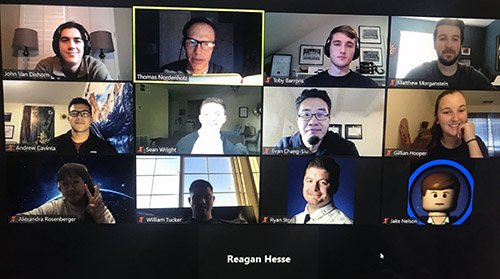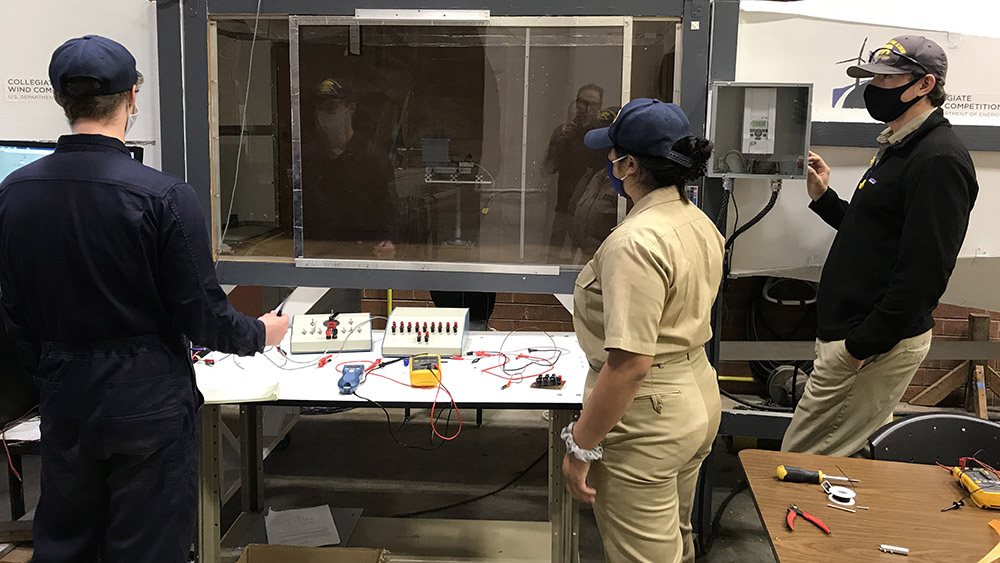Cal Maritime’s Collegiate Wind Competition Team is accustomed to obstacles, so it wasn’t about to let a pandemic get in its way. Determined to continue productive work toward its competition goals, team members adjusted workflows and locations and stayed on task, says Team advisor Tom Nordenholz. “I’ve been incredibly impressed by their ability to take all of this in stride and simply adjust their strategies to meet their goals,” he said.

Alex Rosenberger with 3D printed blades
The Turbine Design subteam decided to refine, build, and test the design from 2020, which showed so much promise in the virtual competition but was never fully built after the campus switched to online learning in March of 2020. Consisting of six senior engineering students – John Van Dixhorn (subteam leader), Toby Barrons, Reagan Hesse, Gillian Hooper, Matt Morganstein, and Alex Rosenberger and advised by Professors Tom Nordenholz and Evan Chang-Siu, not surprisingly, they engineered a solution. The students, all living on campus but with limited access to campus facilities, set up shop in their dorm rooms. Van Dixhorn and Barrons designed and built a first prototype of their axial flux generator while Rosenberger and Hooper designed and 3D-printed their first set of blades. Finally, Morganstein and Hesse redesigned last year’s variable pitch mechanism and 3D-printed and assembled a fully functioning device. Several of these components were tested in the campus wind tunnel in November, with encouraging results and a starting point for improvements next semester.
“The fact that we were able to produce prototypes, let alone test them, is a huge accomplishment,” says Van Dixhorn. “There is something to be said about this teams’ work ethic and the overall dedication, including our advisors. Every team has their challenges, and I can confidently say that we overcame them and will continue to. Our work isn’t done yet, but this is where the fun starts!”
The Project Development subteam consists of four students in three majors – Andrew Cavinta (GSMA 2022, subteam leader), Bowen Fei (FET, 2022), William Tucker (GSMA, 2022), and Sean Wright (IBL, 2021), and are advised by professors Ryan Storz and Christine Isakson. This year’s task specifies that the team design a 100 MW wind farm in western South Dakota, where there is a vast and relatively undeveloped wind resource. The team, all newcomers to the CWC and geographically isolated in their homes hundreds of miles apart, spent the fall 2020 semester researching the geography, wind resource, infrastructure, and economic and environmental conditions of western South Dakota, selecting two possible areas for their wind project, and developing a financial model.
In spring of 2021 they will choose the final site, used the commercial software Openwind to optimize the location of the turbines they have selected (GE 2.5 MW), design the remainder of the site (grid connection, roads, and additional infrastructure) and complete the financial analysis.
“Meeting every Thursday night on Zoom with Professor Storz and the rest of the Project-development has been extremely beneficial,” says Cavinta. “Not only did we discuss our individual deliverables for the competition with him but he also provided a broader understanding of the field of renewable energy. As most of our everyday hobbies have been put on hold due to these unprecedented times, the Wind Team has been a great outlet for my teammates and me.”

Wind Team Meeting on Zoom
Checking in from all corners of the state, the entire team met via Zoom in December where the two subteams presented their progress to each other. “Considering the challenges, it was amazing to see how organized, enthusiastic, and well-versed they were on all aspects of the projects”, said Dr. Nordenholz. “If the team can maintain this level of commitment, they should be track for another successful year.”
The Competition also involves outreach and career development components. The team is planning to give online presentations to high school environmental science classes and will interview several wind energy professionals in various sectors of the industry to learn about their careers. It will also present their projects virtually to alumni and industry advisors in March to help prepare them for their June competition. The Competition will take place virtually alongside the American Wind Energy Association Windpower Conference in June. The team is still going to build and test their turbine at the wind tunnel at Cal Maritime.
Learn more about the Collegiate Wind Competition Team
ABOUT CAL MARITIME
Established in 1929, California State University Maritime Academy is the only degree-granting
maritime academy on the West Coast. Located in Vallejo, California, the campus offers
undergraduate degrees that prepare students for careers in engineering, transportation,
international relations, business, and global logistics. Cal Maritime also offers
a master’s degree in Transportation and Engineering Management, as well as a number
of extended learning programs and courses.
